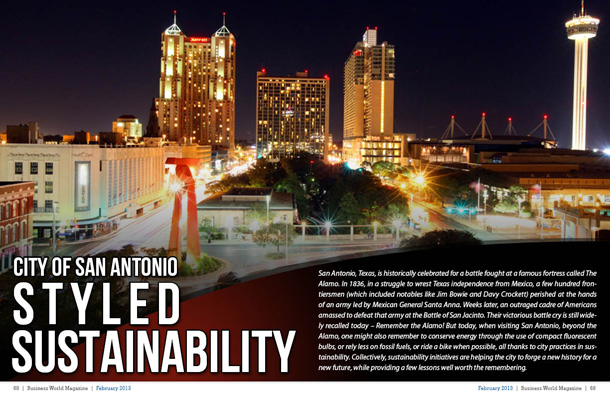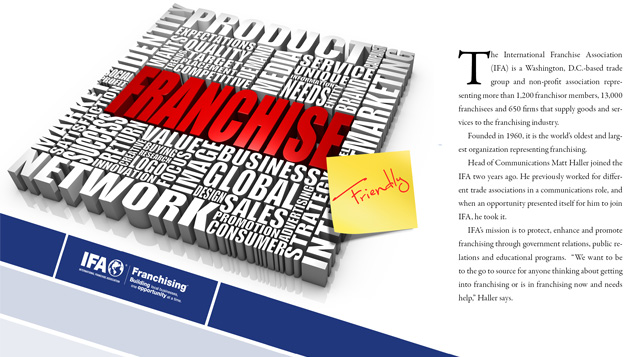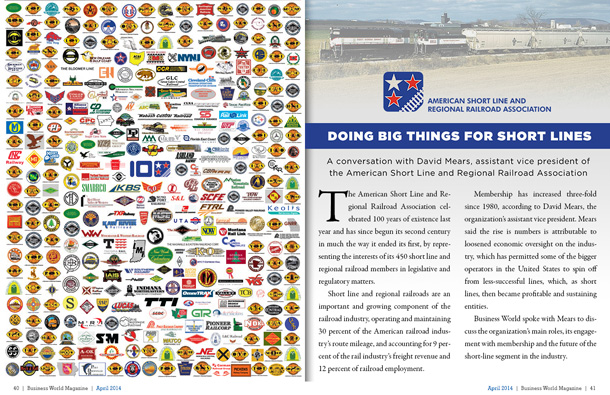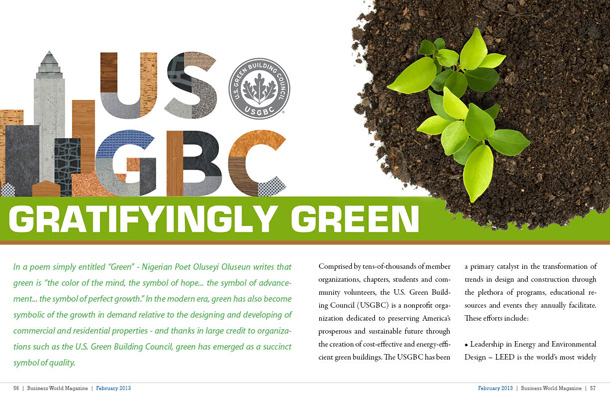
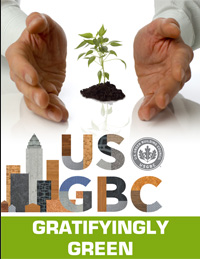
In a poem simply entitled “Green†– Nigerian Poet Oluseyi Oluseun writes that green is “the color of the mind, the symbol of hope… the symbol of advancement… the symbol of perfect growth.†In the modern era, green has also become symbolic of the growth in demand relative to the designing and developing of commercial and residential properties – and thanks in large credit to organizations such as the U.S. Green Building Council, green has emerged as a succinct symbol of quality.
Comprised by tens-of-thousands of member organizations, chapters, students and community volunteers, the U.S. Green Building Council (USGBC) is a nonprofit organization dedicated to preserving America’s prosperous and sustainable future through the creation of cost-effective and energy-efficient green buildings. The USGBC has been a primary catalyst in the transformation of trends in design and construction through the plethora of programs, educational resources and events they annually facilitate. These efforts include:
• Leadership in Energy and Environmental Design – LEED is the world’s most widely recognized green building certification program and has become the most successful voluntary, private, market-driven real estate program in the country. LEED is certifying some 1.6 million square feet of building space each day in more than 130 countries, providing guidance on the design, construction, operations and maintenance. Today, there almost 50,000 various projects participating in LEED, comprising more than 8.9 billion square feet of construction space.
• Greenbuild International Conference & Expo — recognized as the world’s largest and most widely attended green building conference and expo, it annually attracts thousands from around the world who come to gain greater insight on strategies, resources and applications essential to green building.
• Advocacy — USGBC works with its advocates at every level of government to provide policymakers and community leaders with the tools and resources needed to increase awareness of the benefits of building sustainable environments.
• Credentials — from the LEED Green Associate credential to the various LEED AP credentials, USGBC enables professionals to earn a designation that helps distinguish them in the building industry. The conferring of LEED Green Associate and LEED AP credentials serve to validate a professional’s expertise in sustainable design, construction, operations and maintenance of buildings and communities.
• Education — USGBC offers green building educational programs in a variety of formats for professionals from all sectors of the building industry. Thousands of designers, builders, suppliers and managers have attended their seminars, which all support the earning of LEED professional credentials.
• Chapters — With its actively engaged network of more than 79 regional chapter organizations, the USGBC reaches out to communities throughout America, providing them with resources, education and networking opportunities.
LEED’s Leading Advantages
In order for commercial buildings and neighborhoods to achieve LEED certification, a project must comply with all LEED prerequisites, and score a minimum of 40 points on a 110-point LEED rating system scale. The ratings are different for homes, which must earn a minimum of 45 points on a 136-point scale. By adhering to LEED standards, such buildings have demonstrated lower operating costs and increase asset value. Other benefits have involved the reduction of waste sent to landfills, conservation of energy and water, increased health and safety for occupants, and reduction in the emission of harmful greenhouse gases. In many cities throughout America, building to LEED specifications can also pose benefits in the way of qualifying for tax rebates, zoning allowances or other economic incentives.
Roger Platt is the USGBC’s Senior Vice President for Global Policy and Law. When considering the extent to which so many have adopted and embraced green building, Platt says the organization takes great pride in being associated with a movement that has been proven to offer both economic and environmental benefits. Despite the tumultuous era of economic downturn, Platt says the USGBC has been at the center of an “oasis of good news.†Green building is on the rise, he says, because it saves people money, saves energy, and helps local economies. Hundreds of local governments have enacted various policies to promote green building, and LEED is now being used in more than 130 countries.
“It feels like we’ve been riding a wave of engagement with the issues, not only in terms of building, but a wave of corporate responsibility and bipartisan support… we’ve seen a very positive evolution and there’s a lot of excitement as we look toward the future,†says Platt.
Top of FormAs he considers the future, Platt says he anticipates USGBC will find more opportunities to help buildings lead on performance and health. To put the former in proper context, Platt explains that in the past, the USGBC primarily served to encourage green building practices. As those practices have been so exceedingly embraced, the USGBC is now in a position to provide greater insight into the benefits of green building. In the beginning, when such practices had yet to be widely adopted, the USGBC could only provide, what was essentially, theoretical evidence of the cost-savings, efficiencies and environmentally-sensitive qualities they were espousing in this building technique. Of course, over time, projects became the proof that demonstrated the benefits, and the full measure of such evidence is posing a new opportunity for the USGBC to deepen its reach.
“Our standards have been around for twelve years now, and in the past, we were there when a building was about to be built, or just built. What we didn’t have yet was the kind of data to show how a building performs… in terms of the health of the environment, its functioning in the landscape, the efficiencies in its operation… the performance of these buildings is now our number one priority,†says Platt. USGBC is now certifying 1.6 million square feet a day to LEED. More than half of that is in existing buildings.
In gaining a better understanding of performance measures, Platts says the USGBC will continue to find ways to better demonstrate the full value and benefit of green building. In this case, performance evaluations will encompass measurements in efficiency relating to energy use, water use, air quality, and the impact that all these things assert on the environment and operations inside the building.
There is a growing literature of green building research, says Platt. He has been particularly encouraged by a recent study conducted by Notre Dame University. In that study, researchers analyzed data produced by 100 retail locations of PNC Bank. They found that the annual utilities cost per employee in their LEED facilities was $675.26 lower than in non-green facilities. Better performance, in this case, included increased productivity from employees and lower costs of utility rates per square foot than that of other branches. Platt says the research appears sound, and it complements other independent studies that show a stronger value proposition for LEED buildings, such as faster lease rates or higher occupancy rates.
Platt says the USGBC will be undertaking their own research, working with owners and operators of LEED certified buildings, and collect and compare data so the organization can better provide insight into opportunities to improve performance in existing buildings.
The USGBC has created an online resource known as the Green Building Information Gateway (www.gbig.org). The site provides an interface to compare and contrast various LEED certified buildings established throughout the world. Platt says this Internet resource is helping to generate a new era of analytical insight as well as engagement and excitement (not to mention bragging rights) among those who have undergone LEED certification.
Another priority aim for the future relates to issue of healthier buildings. Platt says beyond the conservation of energy and water, the buildings are not simply about the buildings, but the people who live or work in such buildings. He says there has been data that shows less instances of asthma and less types of illness associated with better air quality, as a byproduct of green buildings. “We want to be more ambitious about creating healthier environments… I think when we have more data, we’ll be able to drive another economic argument as well. After all, the cost of energy per square foot of operation is substantial, but nowhere near the significance of the cost of square foot per human resource. Understanding that better is a real aspiration for us… and moving forward, we’ll be working with more medical professionals, universities, and hospitals,†says Platt.
Platt is particularly excited about the work USGBC is doing to advance green schools. Thus far, there are 32 states throughout America where legislatures are promoting greener practices for schools. A good education is a critical component of our long-term prosperity, says Platt, and investing in green schools is good economics that will help our next generation of leaders.


